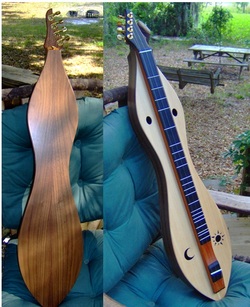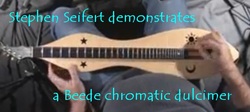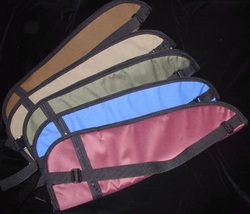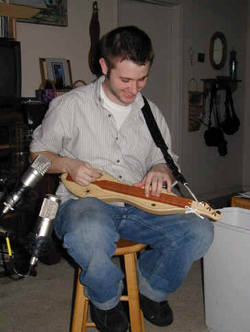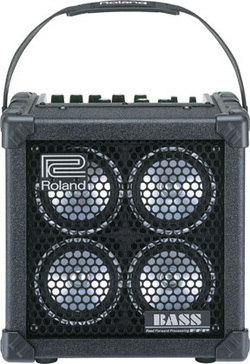Full sized hourglass dulcis
The basics are: Hourglass, upper bout 5.5", lower bout 7.5", body 2 " deep, overall depth 3", length 35", 25" string length.
This hourglass model evolved in collaboration with my friend Aaron O'Rourke , who approached me with a few interesting ideas arising from his playing style. There videos of Aaron playing a couple of the prototypes on the Gallery page. Walnut & Spruce 4 string
Arron O'Rourke playing the 1st prototype.
Click the image to watch Arron play an amazing original piece called "Hi Mom." And checkout his latest album "Prizmatics" |
Octave dulcis
My "classic model" has a poplar body, all oval sound holes and 3 string mahogany "standard fretted" fingerboard [includes 6 1/2 fret] and sells for $345.
Approximately 24" long, 5" wide and 2" deep, they have 1.25" wide fingerboards, 16.5" strings lengths, tuned in DAD an octave above full sized dulcimers. They can also be tuned as low as AEA with satisfactory results. Though child inspired these are very capable instruments that hold their own in a variety of musical settings. Whether you're showing dulcimer fundamentals to little fingers, or floating a high harmony into a dulcimer jam or adding authoritative chop chords in a mixed jam session, these instruments really shine. Perfling
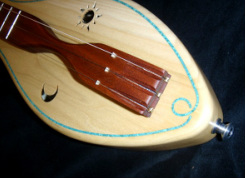
Close-up of turquoise "loop" perfling.
Here's my "Floridian" model with Atlantic white sided dolphins for sound holes.
audio player here
Soft cases available in five colors.
You want to
|
Bass dulcis
These instruments are made of mahogany with turquoise inlay, have polyurethane strings and sound in the range of a stand up bass.
Not to be confused with some "bass" dulcimers out there that actually only go down to a "drop D" on a guitar. Those can be fun for playing an octave below your normal dulcimer, but not to be confused with a "true" bass instrument. The reason nobody makes an actual acoustic bass dulcimer is the size box needed to support those low notes won't really fit on your lap. So mine is solid body and can be played through a variety of bass amps. [More on amps below.] As I mentioned above these instruments can sound fine through pretty basic amps like the BT108 by Behringer for $80. (Got mine for $50 - shop around.)
They also make a BXL 450 for $180 that has more wattage and can fill a larger venue. It is rather heavy though. One of my favorites is the Roland MCB-RX because it is small, very portable and runs on 6 AA batteries for hours. Great for playing around camp fires at festivals. You do pay more for those features at about $280. These are the same folks who make the Micro-cube that so many dulcimer players use now. Peg head
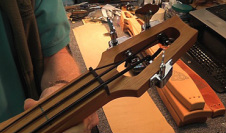
I use Ping bass tuners and Pahoehoe polyurethane strings custom formulated by Road Toad Music. Models & Prices
The fretless model seen above cost $475 - the inlay lines are positioned like a diatonic dulcimer fretboard with the 6 1/2 fret. Technically speaking these are fully chromatic instruments since you can play the notes between the fret lines.
My "acu-fretless" "out lay" model costs $525 - these use slots instead of frets - like inlay grooves without any inlay in them. The string actually gets "fretted" on the forward edge of the groove. You get the accuracy of a fretted instrument and the expressiveness of a fretless. More on that model soon. |
